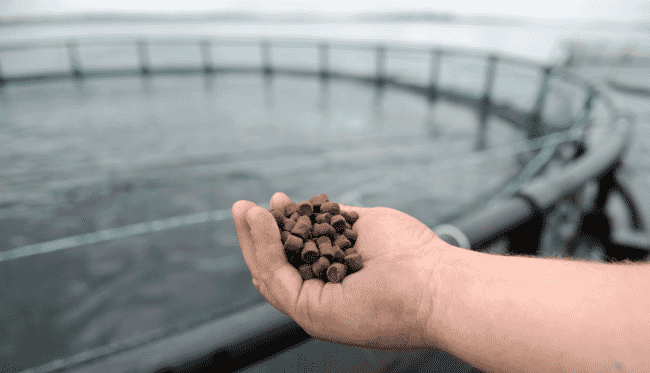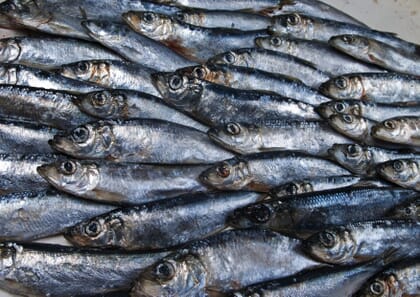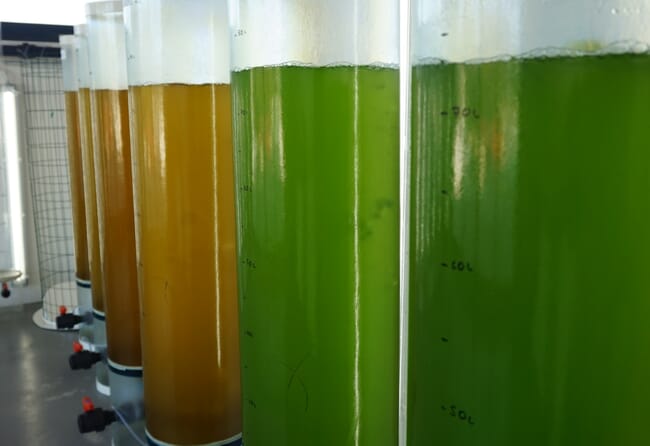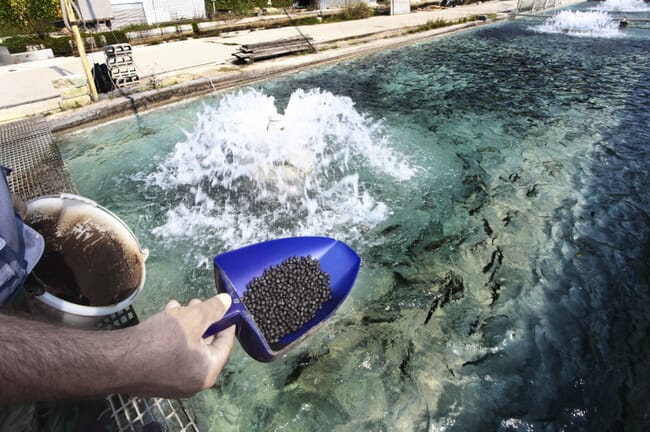A new study published in Nature – Food, has synthesised more than 10 years of studies and data from fed aquaculture operations and found that switching from conventional aquafeeds made from forage fish like herring, sardines and anchovies to aquafeeds made with novel ingredients like insects, algae and yeasts would substantially reduce pressure on wild stocks of forage fish.
However, while the research team found that using novel ingredients to replace fish oil in salmon and shrimp aquaculture could make the entire industry more sustainable in the long-term, their results also indicated that replacing fishmeal with novel aquafeeds wouldn’t reduce forage fish demand to the same extent – nor would it give the same environmental or sustainability benefits.

© Biomar
The researchers stress that adopting novel aquafeeds may not be feasible for all producers. There are multiple regulatory, economic and environmental challenges that accompany switching from conventional aquafeeds to ones based on innovative ingredients – especially for smaller producers. The researchers suggest targeting interventions for fish oil-dependent species like salmonids and marine fish to reduce overall demand for forage fish.
They also call for additional research on low-cost and complementary ingredients that could be widely available for low-value production systems or fish farmers in developing countries. This would allow the aquaculture industry to grow to meet consumer demand, while also remaining environmentally conscious.
Background
Most forms of aquaculture production are dependent on external feed inputs. This usually comes in aquafeeds with high concentrations of fish oil and fishmeal, which are extracted from pelagic forage fish like anchovies, herrings and sardines. Though fishmeal and fish oil are nutritionally dense and produce better quality fish at slaughter, stocks of wild forage fish have been stagnant since the 1980s and some fear stocks could be declining. As aquaculture production expands, industry leaders and environmental advocates have been exploring ways to reduce or replace forage fish in aquafeeds without compromising the quality or health of cultured fish.

Numerous trials have explored the efficacy of corn and soy as replacements for fishmeal and fish oil. However, randomised controlled trials show that corn and soy-based feeds have negative effects on growth, overall health and performance. Fish reared on corn and soy diets also need more feed to reach slaughter weight, leading to poorer feed conversion ratios.
Researchers are currently exploring more innovative ingredients for aquafeeds. Pilot studies have tested the viability of insects, as well as single-cell proteins like microalgae, bacteria and yeasts, as replacements for ingredients derived from forage fish. The results from these trials have been mixed, and in many cases, it’s unclear how these new ingredients could scale on a global level. However, some trials have yielded promising results – demonstrating the possibility of replacing pelagic fish-based ingredients without compromising fish health or finishing quality.
The study
The researchers wanted to visualise the impact adopting novel aquafeeds could have on forage fish demand by 2030. To create their model, the team used national aquaculture production data across all species. They included information on feed efficiencies, dietary composition and feeding practices to predict a baseline global forage fish demand by 2030, as well as two alternative demand scenarios.
The team then synthesised 10 years of fishmeal and fish oil replacement trials and identified the thresholds for replacing forage fish without negatively impacting fish health or performance. From there, they analysed the different demands for forage fish, based on the novel ingredient used to replace them and by the species being produced.
Results and analysis
The researchers projected forage fish demand by 2030 to exceed the historical supply. However, their model suggested that reducing catch volumes by 20 percent could improve the ecosystem and reduce the environmental pressure on fisheries.
Their model also demonstrated that using novel ingredients that are already available will keep demand for forage fish below the environmental threshold, especially if the salmonid and shrimp aquaculture sectors adopt the feeds. However, immediately switching to novel aquafeeds may be out of reach for certain producers and species.

© AlgaRED
The researchers noted that reducing or replacing fish oil in aquafeeds would make a more substantial reduction in forage fish demand than lowering fishmeal levels – it takes more biomass to make one tonne of oil than one tonne of fishmeal. Their projections also showed that the best-case scenario (replacing fishmeal across all taxa at the maximum thresholds) still resulted higher forage fish demand than if fish oil is replaced purely in the salmonid, shrimp and marine aquaculture sectors.
The data on replacing fishmeal and fish oil
When analysing the data on fishmeal and fish oil replacement studies, the researchers split the results between key groups of fish: freshwater fish, shrimps, salmonids and marine fishes. This covered 90 percent of the aquaculture sector’s global forage fish demand.
Based on the content of the studies, the researchers noted that novel ingredients aren’t receiving the same experimental effort as conventional ones. For fishmeal replacement studies, 53 percent of the published data focused on soy, while novel ingredients like microalgae and insects represented 18.7 percent and 16.9 percent of research outputs respectively.
Despite receiving the smallest share of research efforts, insect-based feeds showed the most promising results in fishmeal replacement trials across all species of fish. In many of the studies, researchers could replace fishmeal with insect meal on a 1:1 basis without sacrificing fish health or feed conversion ratios. However, the researchers noted that the insects needed to be raised on high-quality substrates to get the best results.

For the fish oil replacement studies, microalgae showed the greatest potential for replacement. For these studies, researchers used the omega-3 index as a key health and performance indicator.
Multiple trials with shrimps and salmonids showed that fish oil could be replaced on a 1:1 basis with microalgae without any clear changes to the omega-3 index. To compare, soy oil only replaced 30 percent of the fish oil needed to culture marine fish without lowering the omega-3 index. For salmon and shrimp, soy oil could only replace 10 and 25 percent of their fish oil needs before the researchers noticed negative effects.
Adopting the new aquafeeds
Though replacing fish oil with microalgae sounds easy enough on paper, the reality is more complex. Producing algal oil requires access to advanced technologies and expertise. This sort of switch may be out of reach for many small-scale producers, or those who are based in developing economies.
To overcome these barriers to adoption, the researchers suggested targeted policy interventions that would encourage producers to reduce fish oil use. If these policies were geared towards fish oil-dependent species like salmonids and shrimp, it could result in a substantial reduction in global forage fish demand and make the entire industry more sustainable.
Limitations and key conclusions
Though the research team synthesised a decade of experimental data to create these models, some of their analysis is limited. Variables like the species, production system, feeding and supplementation regimes can interact in discrete ways, making analysis highly complex.
Looking at the studies, the researchers acknowledged that 92 percent of the models’ feed trials focused on juvenile fish. This means that some of the ingredient replacement thresholds may not translate across the life cycles of different fish species. In addition, feed combinations and fish species aren’t evenly represented in the models. These uncertainties can impact their overall reliability.
The researchers also stress that “novel” doesn’t always mean “better”. The novel aquafeed industry is in its early stages – the broader environmental burdens of producing microalgae or insect meal haven’t been established. Mass producing microalgae can rely on fossil fuels and creating high-quality insect meal requires high-quality substrates. There are environmental and economic trade-offs with novel aquafeeds that extend beyond baitfish conservation. A more holistic view of sustainability is therefore needed.
Despite these limitations, the researchers concluded that adopting novel aquafeeds where it was feasible would be a critical step in reducing pressure on forage fish and could secure the future sustainability of the aquaculture sector. Economists and the FAO estimate that demand for cultured fish will increase to nearly 80 million tonnes by 2030 – the industry needs to prioritise research and investment in novel aquafeeds to meet this demand.




